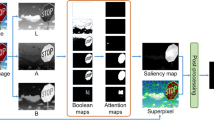Abstract
Salient region is the most prominent object in the scene which attracts to the human vision system. This paper presents a novel algorithm that is based on the separated Red, Green and Blue colour channels. Most prominent regions of all the three channels of RGB colour model are extracted using mean value of the respective channels. Pixels of extracted salient region of RGB channels are counted and then some specified rules are applied over these channels to generate final saliency map. To evaluate the performance of the proposed novel algorithm, a standard dataset MSRA-B has been used. The proposed algorithm presents better result and outperformed to the existing approaches.
Access this chapter
Tax calculation will be finalised at checkout
Purchases are for personal use only
Similar content being viewed by others
References
Achanta, R., Estrada, F., Wils, P., Süsstrunk, S.: Salient region detection and segmentation. In: Gasteratos, A., Vincze, M., Tsotsos, J.K. (eds.) ICVS 2008. LNCS, vol. 5008, pp. 66–75. Springer, Heidelberg (2008). https://doi.org/10.1007/978-3-540-79547-6_7
Achanta, R., Hemami, S., Estrada, F., Süsstrunk, S.: Frequency-tuned salient region detection. In: IEEE International Conference on Computer Vision and Pattern Recognition (CVPR 2009), pp. 1597–1604 (2009). For code and supplementary material http://infoscience.epfl.ch/record/135217
Borji, A.: Exploiting local and global patch rarities for saliency detection. In: Proceedings of the 2012 IEEE Conference on Computer Vision and Pattern Recognition (CVPR), CVPR 2012, pp. 478–485. IEEE Computer Society, Washington (2012). http://dl.acm.org/citation.cfm?id=2354409.2354899
Cheng, M.M., Mitra, N.J., Huang, X., Torr, P.H.S., Hu, S.M.: Global contrast based salient region detection. IEEE TPAMI 37(3), 569–582 (2015)
Cheng, M.M., Warrell, J., Lin, W.Y., Zheng, S., Vineet, V., Crook, N.: Efficient salient region detection with soft image abstraction (2013)
Duan, L., Wu, C., Miao, J., Qing, L., Fu, Y.: Visual saliency detection by spatially weighted dissimilarity, pp. 473–480 (2011)
Goferman, S., Zelnik-Manor, L., Tal, A.: Context-aware saliency detection. IEEE Trans. Pattern Anal. Mach. Intell. 34(10), 1915–1926 (2012). https://doi.org/10.1109/TPAMI.2011.272
Harel, J., Koch, C., Perona, P.: Graph-based visual saliency. In: Proceedings of the 19th International Conference on Neural Information Processing Systems, NIPS 2006, pp. 545–552. MIT Press, Cambridge (2006). http://dl.acm.org/citation.cfm?id=2976456.2976525
He, S., Lau, R.W.: Saliency detection with flash and no-flash image pairs. In: Proceedings of European Conference on Computer Vision, pp. 110–124 (2014)
Hou, W., Gao, X., Tao, D., Li, X.: Visual saliency detection using information divergence. Pattern Recogn. 46(10), 2658–2669 (2013). https://doi.org/10.1016/j.patcog.2013.03.008
Hou, X., Zhang, L.: Saliency detection: a spectral residual approach (2007)
Itti, L., Koch, C., Niebur, E.: A model of saliency-based visual attention for rapid scene analysis. IEEE Trans. Pattern Anal. Mach. Intell. 20(11), 1254–1259 (1998). https://doi.org/10.1109/34.730558
Jiang, B., Zhang, L., Lu, H., Yang, C., Yang, M.H.: Saliency detection via absorbing Markov chain. In: 2013 IEEE International Conference on Computer Vision, pp. 1665–1672 (2013)
Kim, J., Han, D., Tai, Y., Kim, J.: Salient region detection via high-dimensional color transform and local spatial support. IEEE Trans. Image Process. 25(1), 9–23 (2016)
Klein, D.A., Frintrop, S.: Center-surround divergence of feature statistics for salient object detection. In: 2011 International Conference on Computer Vision, pp. 2214–2219 (2011)
Li, Z., Tang, K., Cheng, Y., Hu, Y.: Transition region-based single-object image segmentation. AEU Int. J. Electron. Commun. 68(12), 1214–1223 (2014)
Murray, N., Vanrell, M., Otazu, X., Párraga, C.A.: Saliency estimation using a non-parametric low-level vision model, pp. 433–440 (2011)
Rezazadegan Tavakoli, H., Rahtu, E., Heikkilä, J.: Fast and efficient saliency detection using sparse sampling and kernel density estimation. In: Heyden, A., Kahl, F. (eds.) SCIA 2011. LNCS, vol. 6688, pp. 666–675. Springer, Heidelberg (2011). https://doi.org/10.1007/978-3-642-21227-7_62
Seo, H., Milanfar, P.: Static and space-time visual saliency detection by self-resemblance. J. Vis. 9(15), 1–27 (2009)
Sikha, O., Kumar, S.S., Soman, K.: Salient region detection and object segmentation in color images using dynamic mode decomposition. J. Comput. Sci. 25, 351–366 (2018)
Wang, L., Xue, J., Zheng, N., Hua, G.: Automatic salient object extraction with contextual cue. In: Proceedings of the 2011 International Conference on Computer Vision, ICCV 2011, pp. 105–112. IEEE Computer Society, Washington (2011). https://doi.org/10.1109/ICCV.2011.6126231
Wu, Y.: A unified approach to salient object detection via low rank matrix recovery. In: Proceedings of the 2012 IEEE Conference on Computer Vision and Pattern Recognition (CVPR), CVPR 2012, pp. 853–860. IEEE Computer Society, Washington (2012). http://dl.acm.org/citation.cfm?id=2354409.2354676
Yan, Q., Xu, L., Shi, J., Jia, J.: Hierarchical saliency detection. In: Proceedings of the 2013 IEEE Conference on Computer Vision and Pattern Recognition, CVPR 2013, pp. 1155–1162. IEEE Computer Society, Washington (2013). https://doi.org/10.1109/CVPR.2013.153
Yang, C., Zhang, L., Lu, H., Ruan, X., Yang, M.: Saliency detection via graph-based manifold ranking. In: 2013 IEEE Conference on Computer Vision and Pattern Recognition, pp. 3166–3173, June 2013
Zhang, L., Tong, M.H., Marks, T.K., Shan, H., Cottrell, G.W.: SUN: a Bayesian framework for saliency using natural statistics. J. Vis. 8, 32 (2008)
Zhu, W., Liang, S., Wei, Y., Sun, J.: Saliency optimization from robust background detection. In: Proceedings of the 2014 IEEE Conference on Computer Vision and Pattern Recognition, CVPR 2014, pp. 2814–2821. IEEE Computer Society, Washington (2014). https://doi.org/10.1109/CVPR.2014.360
Author information
Authors and Affiliations
Corresponding author
Editor information
Editors and Affiliations
Rights and permissions
Copyright information
© 2020 Springer Nature Singapore Pte Ltd.
About this paper
Cite this paper
Tripathi, R.K. (2020). A Novel Algorithm for Salient Region Detection. In: Bhattacharjee, A., Borgohain, S., Soni, B., Verma, G., Gao, XZ. (eds) Machine Learning, Image Processing, Network Security and Data Sciences. MIND 2020. Communications in Computer and Information Science, vol 1241. Springer, Singapore. https://doi.org/10.1007/978-981-15-6318-8_33
Download citation
DOI: https://doi.org/10.1007/978-981-15-6318-8_33
Published:
Publisher Name: Springer, Singapore
Print ISBN: 978-981-15-6317-1
Online ISBN: 978-981-15-6318-8
eBook Packages: Computer ScienceComputer Science (R0)




